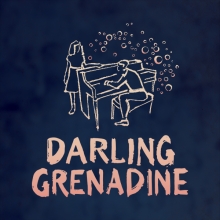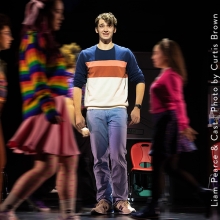
Full Synopsis
Act One
As the show opens, the cast appears in modern dress. Jamie and the other actors sing of their ancestors and the story that's about to unfold ("One upon the Natchez Trace"). By the end of the number, they have shed their modern garb to reveal their 1795 period costumes and the characters that they will portray.
As the number ends, Clemment Musgrove, a wealthy planter, arrives, fresh off the boat from New Orleans with a bag full of gold that he's received for his cotton crop. He's afraid that someone's going to steal his money before he makes it home; nevertheless, he's too exhausted to travel and takes an exorbitant room at the Golden Fleece. Meanwhile, Little Harp has been skulking in the shadows with his pet Raven and a box containing his brother Big Harp's talking head. (Big Harp was beheaded for stealing awhile back, and Little Harp has been the keeper of his noggin ever since.) It quickly becomes clear that Little Harp is the brawn, and Big Harp is the brain of this operation ("Two Heads"), as they prepare to steal Musgrove's bag of gold.
But as they enter Musgrove's room (he's sleeping), Jamie Lockhart is already there. They all pretend to fall asleep, at which point Musgrove wakes up. At knifepoint, Jamie lures him into the closet by telling him that Little Harp, who is now asleep on the floor, is going to kill him. They replace themselves in the bed with sugar cane stalks and hide out. Little Harp wakes up, pummels the bed with a plank, takes the moneybag, puts it under his pillow and goes back to sleep. In the morning, when he arises to an unscathed Musgrove, he's convinced that Musgrove is a ghost and hightails it, leaving behind his bird and Big Harp. Musgrove's grateful to Jamie for saving his life and offers him a reward. When Jamie won't take his money, Musgrove invites him back to his plantation to meet his second wife, Salome, and his beautiful daughter, Rosamund. Although he has numerous opportunities to steal Musgrove's bag of gold, Jamie opts to play the honest man for now, because he believes that there will be greater treasure to steal at the plantation ("Steal with Style"). He does, however, steal Little Harp's raven, and Little Harp vows revenge.
Back at the plantation, Salome is waiting for her husband to return home, and Rosamund is waiting for her knight in shining armor to carry her away ("Rosamund's Dream"). Salome sends Rosamund out to the indigo field to fetch fresh herbs, hoping, as she always does, that the girl will come to ruin. When Musgrove arrives, it's clear that the only thing for which Salome was waiting was the cash from his crop and the muscadine wine. She's enraged when he shows her the beautiful dress and petticoat that he's brought for Rosamund, for she feels that her own beauty goes constantly unrecognized ("Prickle Pear and Lilybud").
Vowing to bring about Rosamund's doom, she enlists the help of Goat, a half-witted boy from town. For a basket of peaches and a suckling pig, Goat agrees to push Rosamund into the ravine as she's picking herbs. He skulks behind her, waiting to strike as she obliviously gathers in her brand new dress ("Ain't Nothin' Up"). But Goat never gets a chance, for Jamie appears, disguised as a bandit with a berry-stained face and steals all her clothes.
Rosamund returns home naked. Salome's shocked that she isn't dead. She and Musgrove disbelieve her story of being robbed by the Bandit of the Woods. After retelling the events 32 times, they are finally won over, and Musgrove vows to send Jamie Lockhart to catch the fiend and avenge Rosamund's honor. Meanwhile, Rosamund goes back to the woods to meet her Bandit once again. In a romantic number, narrated as a well-loved old piece of ancestral lore by the ensemble, Rosamund and Jamie consummate their relationship ("Deeper in the Woods").
Meanwhile, Salome is preparing the house for Jamie Lockhart's arrival. Rosamund, now in love with her bandit, wants no part of him. She covers herself in dirt and pretends to be a goofy simpleton. Musgrove offers Jamie her hand in marriage should he catch the Bandit of the Woods ("Marriage Is Riches"). Jamie asks to have until Wednesday to ponder the offer, for he's in love with the girl whom he met in the woods (but whom he doesn't recognize as Rosamund).
Meanwhile, Goat is still following Rosamund as she goes to Jamie's cabin. She cleans, makes cornbread and changes the sheets, but when Jamie arrives, he's not at all happy to see her there and knocks her unconscious, for he prefers to chase women and not to have them come to him ("Love Stolen").
Act Two
As the second act opens, Rosamund is trying to get the berry stains off of Jamie's face. He tells her, however, that their love must always remain anonymous. He also tells her that he's been offered the hand of a "knock-kneed, cross-eyed" heiress and plans to marry her for "business reasons," keeping his girl from the woods as his lover on the side. Jamie then goes to tell Musgrove that he'll marry Rosamund, only to find that she's been kidnapped by the Bandit of the Woods. Distraught, Musgrove offers him his entire fortune for Rosamund's safe return. Distraught that Musgrove has promised away his money, Salome once again enlists Goat to find where the bandit is hiding Rosamund.
Meanwhile, Little Harp and Big Harp are hankering for some female company when they come across Goat going to fetch Rosamund for the price of Salome's suckling pig. Little Harp offers him everything that he can imagine, including his Big Harp's head, if Goat will bring the girl to them ("Poor Tied up Darlin'"). Goat decides to double deal and brings Little Harp his unwed sister, Airie, covered in a burlap sack. Just then, Jamie, disguised as the Bandit, appears. As they tussle over the girl in the bag, Little Harp sees the berry-stained side of Jamie's face and realizes that Jamie and the Bandit of the Woods are one in the same. Jamie knocks Little Harp out and turns to take the girl in the bag to be married, but she's escaped. He runs off to find her.
Salome decides to take matters into her own hands and goes to Rosamund, who is hiding out in the Bandit's cabin in the woods. She's shocked that Rosamund doesn't know the true identity of her lover and gives her a recipe to remove the berry stains from the Bandit's face. As Rosamund departs to find ingredients for the potion, leaving Salome alone in the cabin, Little Harp arrives with revenge on his mind – he's going to take Jamie Lockhart's girl and throw her into the ravine. He tells Salome, though, that he's on an errand to fetch Jamie's girl for him and bring her to him so that they can make love deep in the woods. Salome offers herself up for the task. Dressed by the ensemble in her dazzling finery, she climbs into the burlap sack, and Little Harp throws her into the ravine ("Salome").
Little Harp thinks that he's made a mistake, though, and returns to the cabin to greet Rosamund. As Little Harp pulls her to the ground, Jamie arrives and kills him. Rosamund soothes Jamie, coaxes him to sleep and wipes off his berry stains ("Sleepy Man"). Realizing that her Bandit is Jamie Lockhart, she reveals herself as the heiress. Rosamund wants to get married, but Jamie wants anonymous love. They fight, and he leaves after telling her to be gone by the time that he returns. Just as she leaves to find him, however, he returns, having changed his mind ("Where Oh Where"). When he can't find her, he decides to go to New Orleans to begin anew.
Meanwhile, a pregnant Rosamund is still looking for Jamie. Ferried along on her journey by the ensemble (and giving birth to twins along the way), she finds Jamie, now a Ship's Captain on the Mississippi. With the blessing of Musgrove, they decide to get married. Rich and prosperous, they live happily ever after ("Finale").
Show History
Inspiration
The Robber Bridegroom is based on the 1942 novella by Eudora Welty, which, in turn, was itself inspired by, and loosely based on, the Grimm fairy tale, The Robber Bridegroom.
Productions
The Robber Bridegroom is a musical with a book and lyrics by Alfred Uhry and music by Robert Waldman. The story is based on the 1942 Eudora Welty novella of the same name, with a Robin Hood-like hero; the adaptation placed it in a late-eighteenth-century American setting.
The Robber Bridegroom started with an early 1970s production in producer Stuart Ostrow's Musical Theatre Lab, which invented the now-standard concept of the "workshop" development process for musicals. The show was further developed in 1975 by John Houseman's group, The Acting Company, a touring group of acting students at the Juilliard School. They took the show to the Saratoga Performing Arts Center in Saratoga Springs, New York, with Kevin Kline as Lockhart, Patti LuPone as Rosamund and Mary Lou Rosato as Salome. It was then staged at the Ravinia Festival in Chicago in the Summer of 1975.
Following the Chicago production, The Robber Bridegroom then made the leap back to New York. The first Broadway production, with the same Ravinia cast, directed by Gerald Freedman and choreographed by Donald Saddler, opened in a limited Broadway engagement on October 7, 1975, at the Harkness Theatre. It ran for fourteen performances and one preview before setting out on a one-year U.S. national tour. Success on the road then convinced the producers to mount a revamped Broadway production with an extended book and expanded, heavily bluegrass-tinged score.
The second Broadway production opened on October 9, 1976, at the Biltmore Theatre, again under Freedman's direction and Saddler's choreography but with a largely different cast. In the shadow of breakout musical A Chorus Line, The Robber Bridegroom ran for a modest 145 performances and twelve previews, closing on February 13, 1977.
Since its debut,The Robber Bridegroom has gone on to be a popular regional production. As Broadway historian Peter Filichia puts it, "This is a favorite show of many people who hate musicals, because it eschews the more obvious conventions and has no trouble being its unpretentious self."
Cultural Influence
- A cast album of The Robber Bridegroom was recorded by the 1976 Broadway cast and released by CBS.
Trivia
- In its original run on Broadway,The Robber Bridegroom was nominated for two Tony Awards, including Best Book of a Musical, and seven Drama Desk Awards, including Outstanding Musical, Outstanding Book of a Musical, Outstanding Lyrics and Outstanding Music.
- In its revival run on Broadway,The Robber Bridegroom was nominated for eight Drama Desk Awards, again including Outstanding Musical, Outstanding Book of a Musical, Outstanding Lyrics and Outstanding Music.
- Between its two incarnations, the show launched the careers of Kevin Kline, Patti LuPone and Barry Bostwick, the last of whom won that season's Tony for Best Leading Actor in a Musical.
- The Robber Bridegroom actually opened on Broadway twice within one year. The first time, in October of 1975, starring Kevin Kline. A second production opened in October of 1976, starring Barry Bostwick. Each was nominated for a Tony in two separate years!
Critical Reaction
"Exuberant spirits and sublime slapstick... it's hard to recall a musical that generated so much unapologetically goofy fun."
– Backstage
"Crowd-pleasing, so-silly-it's-smart humor... flat-out fun."
– Chicago Reader
"Certain to steal the hearts of general audiences."
– Los Angeles Times
"Uhry's script accents the humor, and Waldman's music flies with catchy, southern and country-tinged tunes... infectious."
– Talkin' Broadway
Drama Desk Award
Tony® Award
Connect
Playbil lVault (Original)
Playbill Vault (1976 Revival)
Billing
- Book by
- Music by
- Lyrics by
Based on the novella by Eudora Welty
Requirements
|
Books and Lyrics by
ALFRED UHRY
|
Music by
ROBERT WALDMAN
|
Video Warning
In accordance with the Performance License, you MUST include the following warning in all programs and in a pre-show announcement:ANY VIDEO AND/OR AUDIO RECORDING OF THIS PRODUCTION IS STRICTLY PROHIBITED.
Included Materials
| Item | Quantity Included |
|---|---|
| DIRECTOR'S SCRIPT | 1 |
| LIBRETTO/VOCAL BOOK | 22 |
| PIANO CONDUCTOR'S SCORE | 2 |
Production Resources
| Resource |
|---|
| HOW DOES THE SHOW GO ON-10/CS |
| HOW DOES THE SHOW GO ON? |
| PRODUCTIONPRO-DIGITAL SCRIPT/SCORE |
| REFERENCE RECORDING |
| STAGE WRITE APPLICATION |
STANDARD ORCHESTRATION
| Instrumentation | Doubling |
|---|---|
| BANJO | |
| ELECTRIC BASS | |
| GUITAR | |
| VIOLIN |




